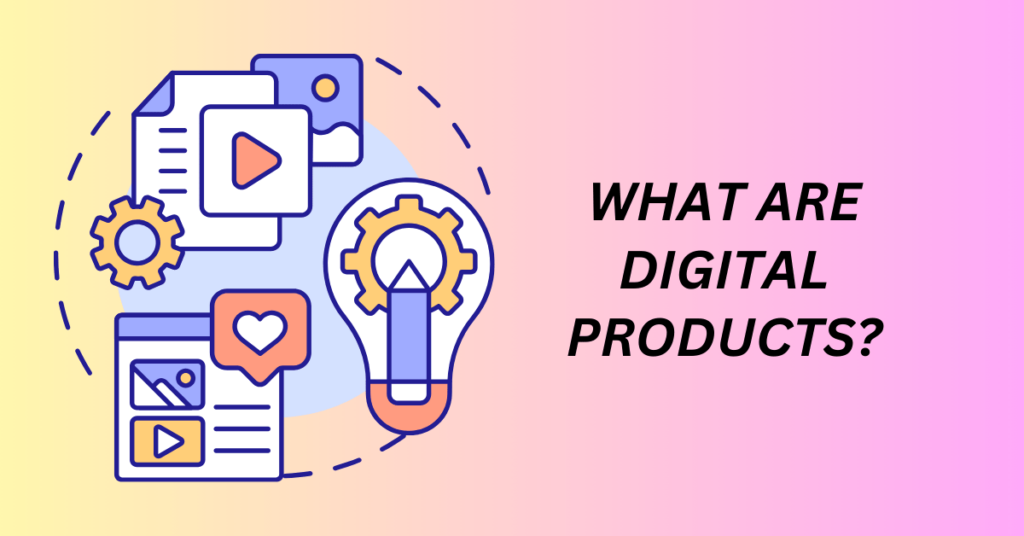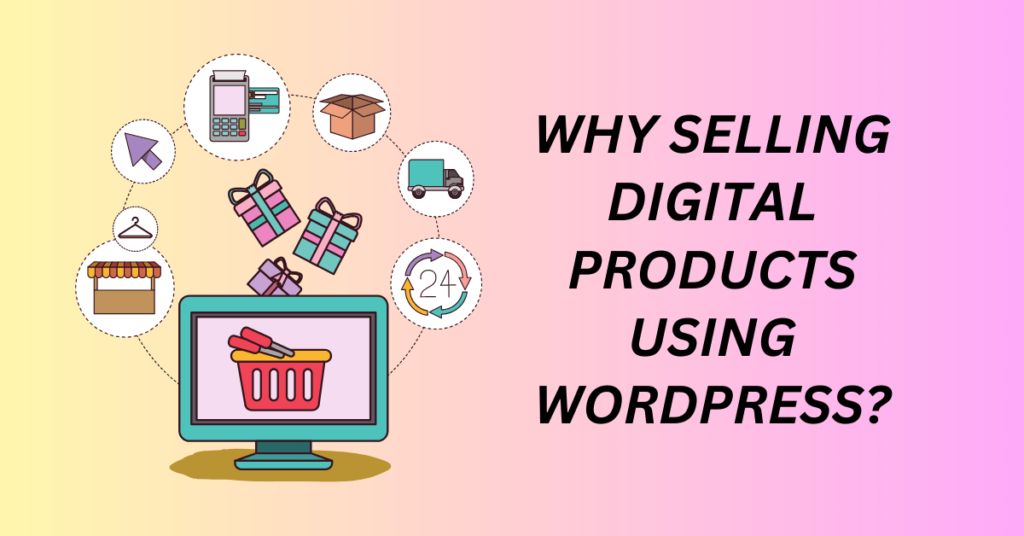One of the ways to translate your passion and expertise into profit is by selling digital products online. Join us as we explore step by step, from defining your niche to effectively marketing your offerings, and unlocking the secrets to successfully sell digital products on WordPress.
Selling Digital Products is good because you don’t need to invest in the inventory. And also, you don’t need to ship the product out physically. Instead, everything can be fulfilled digitally.
And what better platform to embark on this journey than WordPress – a versatile and user-friendly platform that powers a significant portion of the internet?
Whether you’re an artist, a writer, a software developer, or a creative mind brimming with ideas, this guide is crafted to equip you with the knowledge and tools needed to thrive in the digital product marketplace.
Start Your WordPress WooCommerce Store Now
What are Digital Products? – WordPress

A digital product is a virtual or intangible asset that provides a specific function, service, or experience through digital means. Unlike physical goods, digital products exist in a digital format and are accessed through electronic devices such as computers, smartphones, tablets, or other digital platforms.
These products can take various forms, including software applications, e-books, online courses, mobile apps, streaming services, digital art, music, podcasts, and more. Essentially, anything that can be created, stored, and distributed in a digital format falls under the category of digital products.
Types of Digital Products
Software Applications: Programs or applications designed to perform specific tasks or functions. Examples include productivity tools, games, photo editing software, and communication apps.
E-books and Digital Publications: Electronic versions of printed books or digital publications that can be read on e-readers, tablets, computers, or smartphones.
Online Courses and Tutorials: Educational content delivered over the internet, covering a wide range of subjects and skills. Learners can access and participate in these courses from anywhere.
Mobile Applications: Applications designed for mobile devices, often available through app stores. These can range from entertainment and social networking apps to utility and lifestyle apps.
Digital Art and Designs: Visual artwork created digitally, including illustrations, graphics, animations, and 3D models.
Music and Audio Content: Audio recordings, podcasts, and music tracks that can be streamed or downloaded for listening pleasure.
Subscription-based Services: Services that provide ongoing access to digital content or features, usually on a recurring payment basis. Examples include streaming platforms like Netflix, Spotify, and subscription boxes.
Why Selling Digital Products? – WordPress

Selling digital products holds a distinct advantage in today’s tech-savvy market due to its efficiency, cost-effectiveness, and reach. Unlike traditional physical products that necessitate manufacturing, storage, and shipping, digital products can be created and replicated with minimal expense and effort.
This inherent scalability enables businesses to cater to a global audience without the burden of geographical limitations or the costs associated with maintaining a physical supply chain. Additionally, digital products are environmentally friendly, contributing to sustainability by reducing the ecological footprint tied to production, packaging, and transportation.
Start Your WordPress WooCommerce Store Now
Benefits of Selling Digital Products vs Physical Products – WordPress
The advantages of selling digital products are manifold, reshaping the way businesses operate and how consumers interact with products. Here are some of the benefits that make digital products a superior choice over their physical counterparts.
1. Global Reach and Scalability
One of the foremost advantages of selling digital products is the unparalleled scalability they offer. Unlike physical goods that necessitate production, storage, and distribution logistics, digital products can be replicated and disseminated infinitely at virtually no additional cost.
In addition, this scalability allows businesses to cater to a global audience without being hindered by geographical constraints or escalating expenses. Hence, you can allocate your resources towards enhancing product quality and features, ensuring a seamless and delightful user experience.
2. Eco-Friendly and Cost-Effective
Embracing digital products aligns with sustainability, contributing to a greener future. The absence of physical production, packaging, and shipping significantly reduces the ecological footprint associated with traditional commerce.
Moreover, digital products are cost-effective to produce and distribute, eliminating overheads related to manufacturing, storage facilities, and transportation. This translates to higher profit margins for sellers, ultimately benefiting both the business and the environment.
3. Effortless Inventory Management and Instant Gratification
Digital products mitigate the challenges of inventory management faced in the physical goods market. There’s no need to worry about overstocking, obsolescence, or wastage due to changing consumer preferences. Additionally, digital products provide instant gratification to customers who can access and download their purchase immediately after the transaction.
This instantaneous delivery contributes to an enhanced user experience and fosters customer satisfaction, a critical factor in building a loyal customer base.
4. Passive Income Opportunities
Digital products offer the tantalizing prospect of passive income streams. Once created and made available online, digital products can generate revenue continuously with minimal intervention. Creators can focus on developing new offerings while still earning from previously created digital products.
This passive income model provides financial stability and the freedom to invest time and resources into innovation, ensuring a sustainable business model for the long run.
5. Accessibility and Convenience
The advent of the internet and online marketplaces has made digital products incredibly accessible to a global audience. In fact, you can showcase your products on various platforms, reaching a diverse customer base without the need for a physical presence.
Customers can easily browse, purchase, and access digital products with just a few clicks from the comfort of their homes. This convenience enhances the overall user experience, contributing to higher customer satisfaction and increased sales.
The benefits of selling digital products extend beyond convenience and cost-effectiveness. They represent a dynamic shift in how businesses operate and how consumers consume, fostering a more sustainable, accessible, and profitable future for commerce. Embracing this paradigm shift is not just a choice but a strategic necessity for businesses seeking to thrive in the digital age.
6. Higher profit margins
Digital products have higher profit margins than physical products due to their relatively lower production costs. You can create the product once and reproduce it without much cost. And for some instances, it can be free.
You just need to share the link for people to access to your products. This means you will not be facing the issue
Plus, as mentioned, once you develop your product, you can sell it to an unlimited number of people without ever needing to restock. Basically, every sale beyond the initial production is nearly pure profit.
Start Your WordPress WooCommerce Store Now
Why Selling Digital Products Using WordPress?

Selling digital products using WordPress presents a compelling opportunity for entrepreneurs and creators seeking a versatile, customizable, and user-friendly platform to showcase and distribute their offerings.
In addition, WordPress, originally renowned as a robust content management system (CMS) for websites and blogs, has evolved into a powerful e-commerce solution through plugins and themes. Here are several reasons why leveraging WordPress for selling digital products is a smart choice:
Wide Range of E-commerce Plugins
WordPress offers a vast array of e-commerce plugins, such as WooCommerce, Easy Digital Downloads, and Shopify, that seamlessly integrate into the platform. These plugins empower users to set up online stores, manage inventory, process payments securely, and deliver digital products to customers.
WooCommerce, for instance, is highly customizable and accommodates various types of digital products, making it a popular choice for e-commerce ventures.
Cost-Effectiveness and Flexibility
Utilizing WordPress for selling digital products is cost-effective, especially for small to medium-sized businesses or individual creators. The platform provides flexibility in terms of design, features, and functionalities through various themes and plugins.
You can choose from a plethora of free and premium options to tailor your online stores to match your branding and user experience preferences without breaking the bank.
Ease of Use and Management
WordPress is renowned for its intuitive interface and user-friendliness. In addition, setting up an online store to sell digital products is relatively simple, even for individuals with limited technical expertise.
The platform enables easy product management, order tracking, customer communication, and seamless integration with popular payment gateways. Hence, this user-friendly experience allows creators to focus more on product development and marketing.
Scalability and Growth Potential
WordPress provides scalability as businesses grow and diversify their product offerings. As your digital product catalogue expands, WordPress can adapt to the increased demand and complexity of your e-commerce operations.
Whether you’re selling e-books, software, online courses, or digital art, WordPress can scale to meet your requirements and handle higher traffic without compromising performance.
Start Your WordPress WooCommerce Store Now
How to Start Selling Digital Products on WordPress?

With the right strategy and tools, you can effectively showcase and sell your digital products to a global audience. We’ll walk you through nine detailed steps to help you get started and succeed in the world of digital product sales.
Step 1. Define Your Niche – Selling Digital Products on WordPress
Firstly, defining your niche is about identifying a specific area or topic that aligns with your expertise and passion. It’s about finding your unique selling proposition in the vast digital market.
For instance, your niche could be web development, digital marketing, or graphic design. Choosing a niche allows you to target a particular group of people who share an interest in what you offer.
It guides the creation of digital products that cater directly to the needs and preferences of your chosen niche, giving you a competitive advantage in the market.
Step 2: Identify Your Audience – Selling Digital Products on WordPress
Then, understanding your target audience is crucial for the success of your digital product venture. Conduct thorough market research to comprehend the demographics, behaviours, and pain points of your potential customers.
This step helps you tailor your digital products to meet the specific needs and preferences of your audience. Knowing your audience enables you to craft effective marketing strategies, personalize your product offerings, and deliver a superior customer experience, all of which contribute to increased sales and customer satisfaction.
Step 3: Create Your Digital Product – Selling Digital Products on WordPress
Once you’ve defined your niche and identified your target audience, it’s time to develop your digital product. Whether it’s an e-book, online course, software, or any other digital content, focus on creating something valuable and impactful.
Your digital product should address a problem, provide solutions, or enhance the knowledge and skills of your audience. Pay attention to the quality, relevance, and presentation of your product to ensure it resonates with your target audience and establishes your credibility in your chosen niche.
Step 4: Create Your WordPress Website – Selling Digital Products on WordPress
Creating a WordPress website forms the foundation for showcasing and selling your digital products. This step involves several key elements to ensure your website is professional, functional, and aligned with your brand.
1. Domain Name and Hosting:
Start by selecting and registering a domain name that represents your brand or niche. The domain should be memorable, easy to spell, and relevant to your offerings.
Next, choose a reliable web hosting provider that suits your needs in terms of storage, bandwidth, and website performance. The hosting service stores your website’s data and makes it accessible on the internet.
Start Your WordPress WooCommerce Store Now
2. WordPress Installation:
Once you have a domain and hosting, install WordPress on your domain. Most hosting providers offer a simple one-click installation process, making it easy to set up your website.
Log into your hosting account, locate the WordPress installer, and follow the instructions to install WordPress on your domain.
3. Choose a Theme:
Select a WordPress theme that aligns with your brand identity and showcases your digital products effectively. Themes control the design and layout of your website, including colours, fonts, and overall appearance.
Customize the theme to match your branding, and ensure it provides a good user experience for visitors.
4. Essential Plugins:
Install essential plugins to enhance the functionality of your website. For selling digital products, consider plugins like WooCommerce for eCommerce capabilities, an SEO plugin (e.g., Yoast SEO) to optimize your site for search engines, and a security plugin (e.g., Wordfence) to protect your website from potential threats.
5. Create Pages and Structure:
Create essential pages such as Home, About Us, Contact, and Blog to provide key information about your brand, products, and how to get in touch. Organize the structure of your website, ensuring it’s intuitive and easy to navigate. Consider creating dedicated pages for each category of digital products you plan to offer.
6. Optimize for Performance:
Optimize your website for speed and performance to ensure a seamless user experience. Compress images, minimize code, and enable caching to reduce load times. A fast website is crucial for retaining visitors and improving search engine rankings.
7. Mobile Responsiveness:
Ensure your website is mobile-friendly and responsive on various devices such as smartphones and tablets. A significant portion of internet traffic comes from mobile users, so it’s essential that your website functions flawlessly across all screen sizes.
Step 5: Install an eCommerce Plugin – Selling Digital Products on WordPress
To convert your WordPress site into a fully functional online store, you’ll need to install an eCommerce plugin. WooCommerce is a popular choice due to its extensive features and user-friendly interface. It allows you to display your digital products, manage inventory, handle transactions, and configure essential eCommerce settings.
The plugin provides a seamless shopping experience for your customers, enabling them to browse, select, and purchase your digital products effortlessly.
Upon activation, WooCommerce will guide you through a setup wizard. It will prompt you to configure essential settings like currency, payment methods, shipping options, and tax settings. Follow the prompts to customize these settings according to your business requirements.
Read more: Starting Your WooCommerce Store
Step 6: Add Products to Your Store – Selling Digital Products on WordPress
With your eCommerce plugin in place, start adding your digital products to your online store. Create product listings for each item, including engaging descriptions, attractive visuals, and accurate pricing.
Then, organize your products into relevant categories to simplify navigation for your customers. Ensure that your product pages provide comprehensive information and highlight the benefits of each digital product, enticing potential buyers to make a purchase.
Step 7: Set Up Payment Processing – Selling Digital Products on WordPress
Integrate secure payment gateways into your online store to enable smooth and secure transactions. Choose payment processors like PayPal, Stripe, or other popular options to handle payments from customers.
Configure the payment settings, ensuring a seamless checkout process that instils confidence and trust in your audience. Implementing a reliable payment processing system is crucial for building credibility and encouraging customers to complete their purchases without any concerns.
Step 8: Customize Your Online Store – Selling Digital Products on WordPress
Personalize the design and layout of your online store to align with your brand identity and create a memorable user experience. Customize the colour scheme, typography, and overall aesthetics of your website to reflect your brand’s personality.
Ensure that the website design is responsive and optimized for various devices, providing a consistent and appealing appearance regardless of the platform used by your visitors. A well-designed and visually appealing online store enhances engagement and encourages customers to explore your digital product offerings.
Step 9: Test and Launch Your Store – Selling Digital Products on WordPress
Before officially launching your online store, thoroughly test its functionality and usability. Test the purchase process, payment gateways, and download procedures for your digital products.
Address any issues or glitches that may arise during testing to ensure a smooth experience for your customers. Once you’re confident in the performance and functionality of your store, officially launch it to the public.
Promote your digital products, engage with your audience, and monitor your sales and customer feedback to continuously improve and grow your online business. Your digital product venture is now ready to make its mark in the digital marketplace.
Start Your WordPress WooCommerce Store Now
How to Market Digital Products – WordPress
Effectively marketing digital products involves a dynamic approach that encompasses various strategies to capture the attention of your target audience. Firstly, understanding your audience deeply is pivotal. Then, conduct thorough market research to grasp their unique demographics, preferences, and pain points.
With this knowledge, you can then tailor your product messaging and marketing strategies to directly address their specific needs and demonstrate how your digital product offers valuable solutions.
In addition to understanding your audience, leveraging diverse online platforms and channels is essential. You can also utilize the power of social media platforms, content marketing, email campaigns, and search engine optimization (SEO) to amplify the visibility of your product.
Then, engage your audience with compelling storytelling, visually appealing content, and regular updates about your digital products. Collaborate with influencers or industry experts to broaden your reach and establish credibility within your niche.
Furthermore, harnessing the potential of customer testimonials and reviews is a potent marketing tool. Encourage delighted customers to share their experiences and reviews, showcasing the benefits and effectiveness of your digital products. Positive feedback helps build trust and confidence in potential buyers.
Additionally, consider implementing exclusive promotions, discounts, or limited-time offers to create a sense of urgency and incentivize purchases. A robust marketing strategy not only attracts customers but also fosters a loyal customer base, paving the way for sustained success in selling your digital products.
Final thoughts: How to Sell Digital Products using WordPress
You’ve now gained a wealth of knowledge on selling digital products using the power and versatility of WordPress. This journey has been about more than just transactions. Instead, it’s been about crafting your vision, building a brand, and connecting with a community that values your expertise and creativity.
The digital landscape is ever-evolving, and so are the strategies for success. Stay curious, keep innovating, and adapt to the changing trends in technology and consumer expectations. Continuously seek ways to enhance your digital products, engage with your audience, and refine your marketing strategies.





